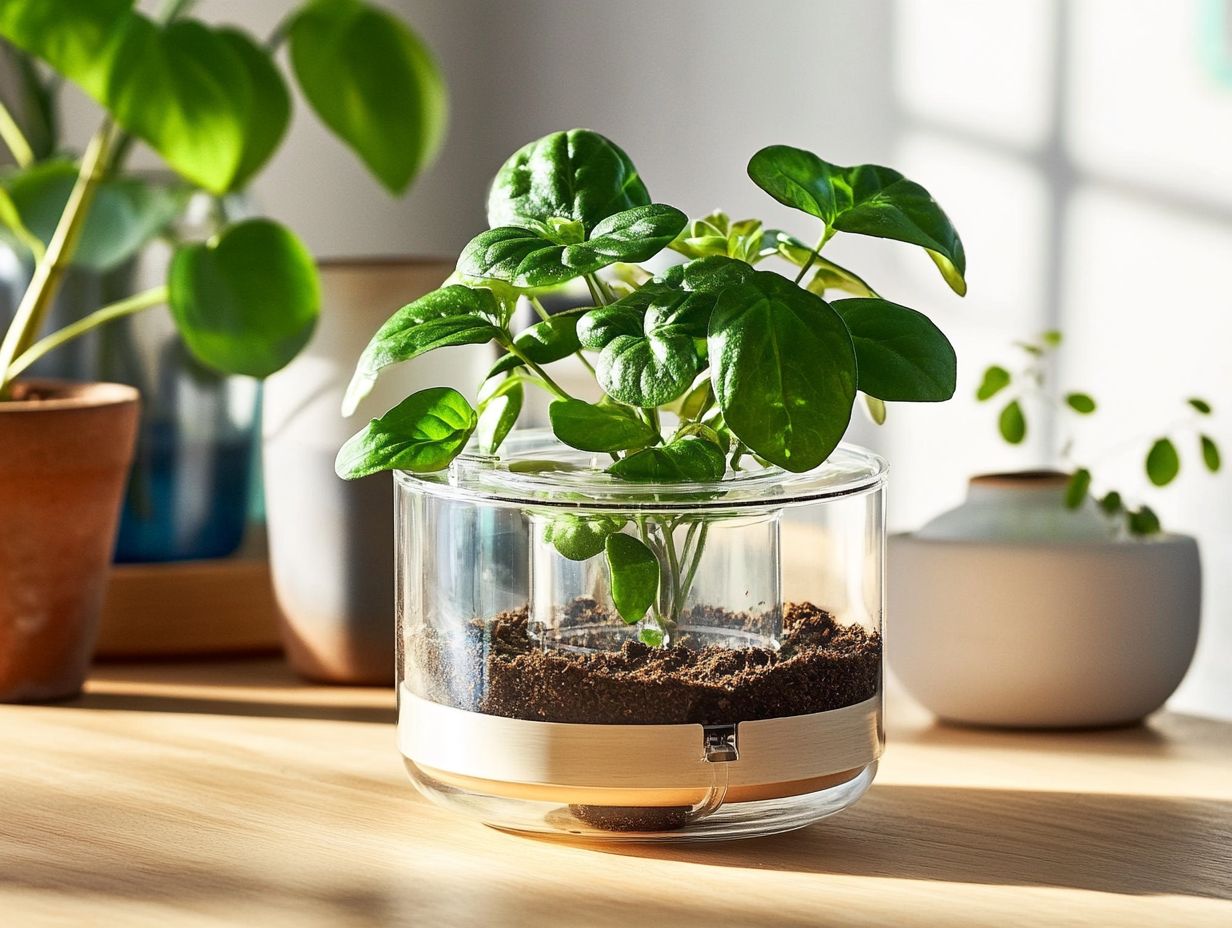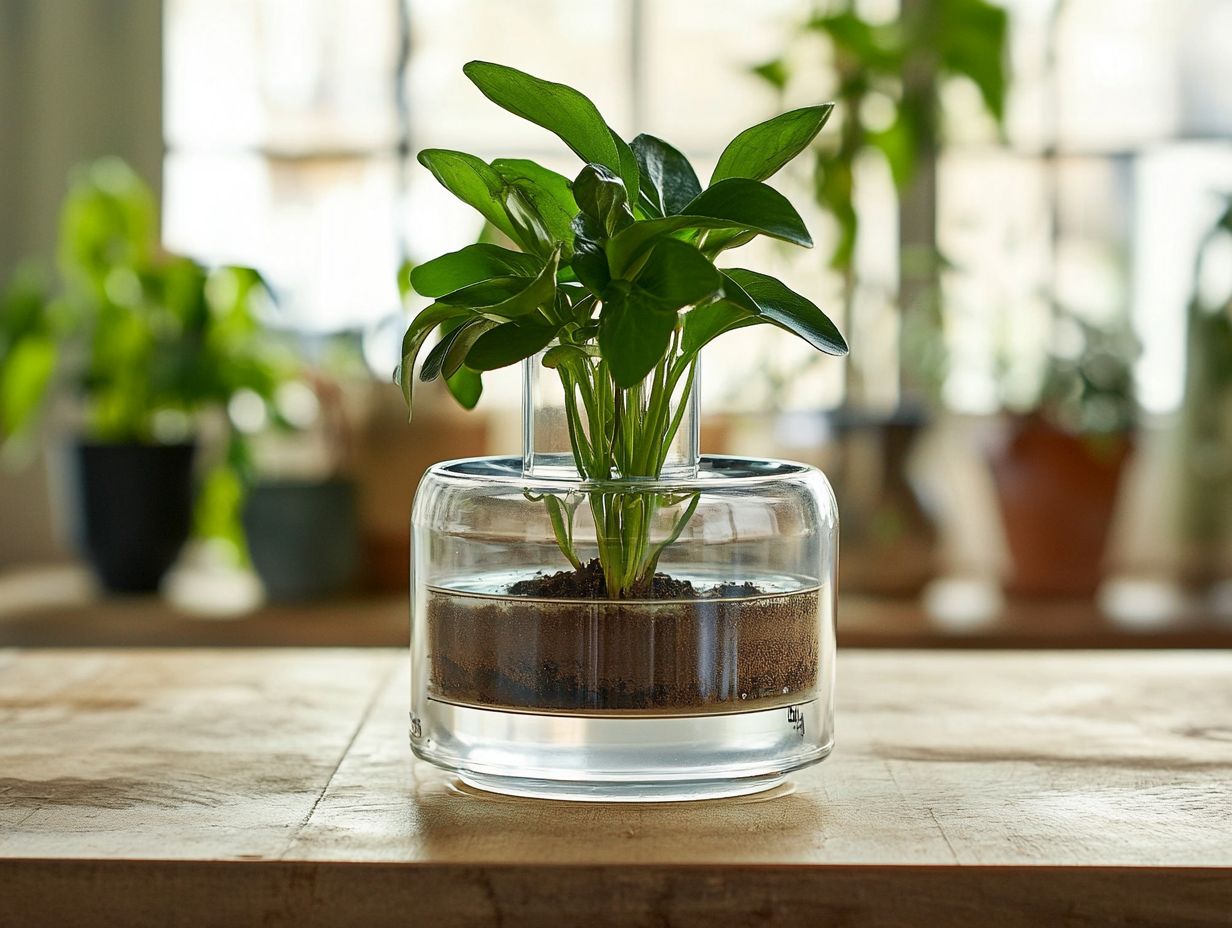Eco-Friendly Travel in Italy: A Quick Guide
Are you weary of the never-ending concern over your houseplants’ watering needs? Self-watering systems might just be the answer you’ve been seeking.
In this exploration, you’ll uncover the many advantages these systems offer, the different types available, and a guide to crafting your own DIY version.
You ll also discover insightful tips for preparing your plants, maintaining the system, and steering clear of common pitfalls. Whether you re a seasoned plant lover or just starting your green journey, learn how self-watering systems can simplify your plant care routine.
Contents
- Key Takeaways:
- 1. Benefits of Self-Watering Systems for Houseplants
- 2. Types of Self-Watering Systems
- 3. Materials Needed
- 4. Step-by-Step Guide to Making a Self-Watering System
- 5. Preparing Your Houseplants for the Self-Watering System
- 6. Tips for Maintaining and Troubleshooting Your Self-Watering System
- 7. Alternative Options for Self-Watering Systems
- 8. How to Choose the Right Self-Watering System for Your Houseplants
- 9. Common Mistakes to Avoid When Using a Self-Watering System
- 10. DIY vs. Store-Bought Self-Watering Systems
- How Often Should You Water Your Houseplants with a Self-Watering System?
- What Are the Best Types of Plants for Self-Watering Systems?
- Can You Use a Self-Watering System for Outdoor Plants?
- How Can You Tell If Your Houseplant Is Getting Too Much or Too Little Water?
- What Are the Benefits of Using a Self-Watering System for Larger Plants?
- How Can You Make Your Own Self-Watering System with Recycled Materials?
- Frequently Asked Questions
- What are DIY self-watering systems for houseplants?
- Why should I consider using a DIY self-watering system for my houseplants?
- What types of materials can be used to create a DIY self-watering system?
- Do I need any special skills or tools to make a DIY self-watering system for my houseplants?
- How often do I need to refill the water in a DIY self-watering system?
- Are there any downsides to using a DIY self-watering system for houseplants?
Key Takeaways:

- Self-watering systems save time and effort by providing consistent watering for houseplants.
- There are various types of self-watering systems available, including wick, reservoir, and drip systems.
- DIY self-watering systems can be easily made with basic materials like wine bottles or plastic bottles and customized to fit your specific plant’s needs.
1. Benefits of Self-Watering Systems for Houseplants
Self-watering systems are a big improvement in the world of houseplant care. They bring a wealth of benefits that elevate both plant health and your ease of maintenance.
With these systems in place, your potted plants receive a consistent supply of moisture. This means you can water less frequently while avoiding the pitfalls of overwatering and underwatering. This is especially helpful if you lead a busy lifestyle.
You ll notice healthier growth in your houseplants, including delicate orchids and resilient peace lilies. Plus, self-watering solutions help maintain optimal drainage, enhancing the well-being of your indoor garden.
By adopting these systems, you significantly improve moisture retention in the soil. This allows your plants to draw the water they need over an extended period, fostering robust root networks that are less susceptible to diseases like root rot.
Take succulents and snake plants, for example. They thrive in these environments, enjoying the water they need without your constant supervision. Even low-maintenance plants like spider plants or pothos become easier to care for, allowing you to enjoy lush greenery without the daily stress of upkeep.
Ultimately, integrating self-watering systems makes gardening accessible and enjoyable for everyone!
2. Types of Self-Watering Systems
You ll find a variety of innovative self-watering systems designed for houseplants. Each is tailored to meet diverse gardening needs and preferences, making your plant care routine a breeze.
The greenhouse method features a water reservoir that maintains consistent moisture. The wick method cleverly uses materials like cotton rope to pull water to your plants. Additionally, the science of watering indoor plants explains how watering globes provide an automatic solution, gradually releasing water to ensure your houseplants thrive even when you’re away. Each method offers unique benefits suited to different types of potted plants.
For instance, the wick method is celebrated for its efficiency, especially with moisture-loving houseplants like peace lilies and spider plants. However, it may require occasional maintenance to avoid clogging.
On the other hand, watering globes are incredibly user-friendly and ideal for plants that require less frequent watering, such as succulents and cacti. Just keep an eye out, as they can sometimes lead to overwatering if the soil is too compact.
Choosing the right system not only complements the types of houseplants you have but also aligns with your lifestyle, ultimately enhancing your gardening experience. Curious about how to build your own? Get started today!
3. Materials Needed
Ready to revolutionize your gardening with a self-watering system? Creating your own self-watering system opens the door to a world of possibilities using materials often found right in your home.
Think about it a simple plastic or wine bottle can become an efficient water reservoir. Cotton rope works wonders as a wick that draws moisture up to your plants.
PVC pipes can be your best friend for drip irrigation, ensuring your houseplants receive just the right amount of hydration without daily watering hassle. It s all about low maintenance and effective plant care.
Many of these items are easily sourced from local thrift stores or recycled from what you already have. For example, you can repurpose terracotta pots into wicking pots by pairing them with a water reservoir. Old shoelaces or strips of fabric can serve as budget-friendly wicking solutions instead of cotton rope.
This approach is eco-friendly; it keeps waste out of landfills while nurturing a flourishing garden. By rummaging through your home for these resources, you ll spark creativity in sustainable gardening and turn simple materials into innovative self-watering systems.
4. Step-by-Step Guide to Making a Self-Watering System
Building a self-watering system for your houseplants can transform your gardening experience, making it both rewarding and efficient. Your beloved potted plants will receive the hydration they need.
By automating the watering process, you save valuable time and significantly reduce the risk of over-watering or under-watering two common pitfalls for plant enthusiasts. Grasping your plant’s specific moisture requirements is essential to adjust the water levels accordingly.
As you gather your materials, remember how each method affects drainage. Excess water must escape to prevent root rot, which happens when plants sit in too much water, causing the roots to decay.
Consider drawing diagrams to visualize your setup. Highlight key elements such as the water reservoir, how the wick sits, and where the water goes. Paying attention to these details will create a thriving environment for your cherished green companions.
5. Preparing Your Houseplants for the Self-Watering System
Properly preparing your houseplants is key to success before introducing them to a self-watering system. This ensures they adapt smoothly and thrive in their environment.
Start by assessing the current moisture levels in the soil. If the plants are too dry, a preliminary watering may be necessary to establish a good baseline.
Pay attention to the drainage capabilities of your pots to prevent waterlogging. Waterlogging can lead to root rot. With just a few thoughtful steps, you can set your houseplants up for a successful transition to a self-watering system, enhancing your overall plant care experience.
Different plants have varying moisture needs. For example, succulents generally prefer drier conditions while tropical varieties like ferns thrive in consistently moist soil. When making the shift to self-watering, gradually acclimate your plants to their new setup.
Start by observing how quickly they absorb water and adjust the levels accordingly. Don’t overlook placement; factors like light and temperature significantly influence moisture utilization. By carefully monitoring these elements and making necessary adjustments, your houseplants will flourish in their new self-sustaining watering conditions.
Gather your materials today and start building your system for thriving plants!
6. Tips for Maintaining and Troubleshooting Your Self-Watering System

Maintaining your self-watering system is vital for your houseplants’ health. A bit of attention can improve your plant care significantly.
Regularly checking moisture levels helps prevent root rot. It also ensures your plants get the right amount of water to thrive.
Use a tool to measure soil wetness for precise readings, or simply stick your finger into the soil to assess its dryness. If you notice any signs of algae growth, act quickly to remove it! Algae can obstruct water flow.
Cleaning elements like cotton wicks and water reservoirs is essential, especially during seasonal changes when your plants needs may fluctuate. By consistently implementing these straightforward tasks, you can maintain an effective self-watering system that fosters healthy growth and minimizes common issues.
7. Alternative Options for Self-Watering Systems
If traditional self-watering systems aren’t quite your gardening vibe, you have a range of alternative options, such as watering globes. These can still deliver efficient hydration for your beloved houseplants.
Each method offers unique benefits tailored to fit specific plant types or gardening scenarios. For example, watering globes are user-friendly and maintain consistent moisture levels for individual potted plants, making them excellent for smaller indoor gardens.
Soaker hoses shine when it comes to vegetable gardens and flower beds, delivering water directly to the roots while minimizing evaporation talk about efficiency! Drip irrigation takes it up a notch by using a network of tubes and emitters for precise watering, perfect for larger landscapes or areas with diverse plant needs.
Explore these alternatives to ensure your plants get the best care, promoting their healthy growth and vitality.
8. How to Choose the Right Self-Watering System for Your Houseplants
Selecting the right self-watering system for your houseplants is crucial. Different plants have unique moisture needs and root structures.
It s essential to recognize that certain plants require specific watering regimes. For instance, succulents flourish in well-draining soil and prefer to dry out between waterings. A simple drip irrigation system works effectively for them.
In contrast, if you have a lush fern that craves constant moisture, it would benefit from a more sophisticated self-watering system with a reservoir. This provides consistent hydration without the risk of over-saturation.
Don t overlook pot size. Larger containers meant for shrubs or floral arrangements may need a system designed to handle greater volumes of water. A wicking system, which uses a cotton wick to draw moisture from a reservoir, could be the perfect solution.
By carefully assessing these factors, you can choose the most suitable self-watering mechanism, paving the way for a flourishing indoor garden.
9. Common Mistakes to Avoid When Using a Self-Watering System
When you’re utilizing a self-watering system, it s essential to steer clear of common mistakes that could jeopardize your plants’ health and growth. This ensures you practice optimal plant care.
One frequent error is overestimating how much water your plants really need. Many gardeners fill their reservoirs to the brim, leading to poor drainage and root rot a fate no plant deserves.
To avoid these pitfalls, make it a habit to check the moisture sensor regularly or stick your finger into the soil to feel for dampness before topping up any reservoirs. Using pots with adequate drainage holes will help eliminate standing water and keep your plants happy.
Lastly, getting to know your specific plants water requirements will allow you to tailor your approach, helping you cultivate a thriving green oasis.
10. DIY vs. Store-Bought Self-Watering Systems
When you’re deciding between DIY and store-bought self-watering systems for your houseplants, it’s crucial to weigh the advantages and disadvantages of each option. Both can serve as effective solutions for nurturing your greenery.
A DIY approach is also a great way to express your creativity in your gardening space. You can tailor the system specifically to your plants’ needs, ensuring they receive just the right amount of water. However, if you re leaning towards convenience, store-bought systems usually come with established designs and user-friendly instructions. This significantly reduces the chances of error, making them particularly appealing for those with busy lifestyles. Many pre-made systems even incorporate advanced technology, like moisture sensors, taking the guesswork out of watering entirely.
By evaluating your personal preferences and circumstances, you can strike a harmonious balance between the joy of hands-on gardening and the ease of ready-made solutions.
How Often Should You Water Your Houseplants with a Self-Watering System?
Determining how often to water your houseplants with a self-watering system can greatly influence their growth and health. Different plants have unique moisture needs. Generally, you can reduce your watering frequency to once every few weeks, depending on factors like humidity, temperature, and the specific types of plants in your home.
Keep an eye on the moisture levels in the soil. This will help you know when it s time to refill the water reservoir, ensuring your plants receive optimal hydration without the risk of overwatering.
Take tropical plants like peace lilies, for example they thrive on consistent moisture and love humid environments. In contrast, succulents and cacti are more comfortable in drier conditions. Observing the humidity and temperature in your space is important. Using a moisture meter can provide precise readings to refine your watering schedule. Checking the top inch of soil is also smart; if it feels dry, it’s time to top off that reservoir.
By understanding these environmental factors, you can craft a tailored care regimen for each plant s specific needs, ensuring they flourish under your watch.
What Are the Best Types of Plants for Self-Watering Systems?

Selecting the right plants for your self-watering systems is key to reaping the full benefits of this innovative plant care method. Some plants simply thrive in these conditions, while others do not.
If you choose plants that enjoy consistently moist soil and have high humidity needs, they will flourish in these systems. The steady supply of water allows them to maintain their lush growth without the worry of overwatering.
Houseplants like pothos and philodendrons are fantastic choices. They adapt well to varying light conditions and thrive with the automated watering process. On the other hand, succulents prefer drier environments, making them less suitable for this setup.
By selecting species that naturally thrive in humid, moisture-rich settings, you ll create a stunning indoor garden that will impress everyone!
Can You Use a Self-Watering System for Outdoor Plants?
Self-watering systems can be an excellent choice for your outdoor plants. They offer a seamless solution for maintaining the right moisture levels in your garden. Just like their indoor counterparts, these outdoor systems allow you to water less frequently while ensuring your plants receive consistent hydration especially beneficial during those hot, dry spells.
You can opt for tailored solutions like drip irrigation systems or soaker hoses to meet the specific watering needs of various outdoor plants. These methods promote robust growth while minimizing maintenance.
With these systems in place, you ll find yourself spending less time fussing over your plants and more time enjoying your outdoor oasis. For instance, tomatoes, peppers, and herbs flourish in environments where moisture levels are kept in check, making them perfect candidates for such systems.
By incorporating a self-watering method like a rain barrel or a smart irrigation controller, you can further optimize water efficiency. This approach conserves resources and encourages lush foliage and bountiful harvests, all while alleviating the daily stress of watering your garden.
How Can You Tell If Your Houseplant Is Getting Too Much or Too Little Water?
Recognizing whether your houseplant is receiving too much or too little water is essential for effective plant care.
Understanding the delicate balance between moisture and dryness is particularly crucial in self-watering systems. When you overwater, the roots can drown, creating an inviting environment for bacteria, leading to mushy stems and dark, watery spots on the leaves. If your plant is underwatered, you’ll likely notice leaf curling or browning along the edges, signaling that it s thirsting for the moisture it needs to grow well.
To maintain optimal moisture levels in your self-watering setups, make it a habit to check the water reservoir regularly ensure it s neither overflowing nor completely dry. Adjusting your watering schedule according to seasonal changes and the specific needs of your plants will help keep your green companions healthy and vibrant.
What Are the Benefits of Using a Self-Watering System for Larger Plants?
Using a self-watering system for your larger plants can bring a wealth of benefits, enhancing both their health and your ease of care, especially if you re dealing with plants that have high watering needs.
This not only supports growth but also allows you to maintain a low-maintenance routine, giving you more time for other gardening endeavors without compromising on the care your plants deserve.
This system also promotes even hydration, which is crucial for robust growth in houseplants like the fiddle leaf fig or monstera both of which thrive on consistent moisture levels. With reduced watering frequency, you ll spend less time managing your outdoor or indoor gardens, allowing you to focus on nurturing a diverse collection. The reliability of a self-watering setup minimizes the stress that often accompanies plant care.
You can ensure these larger plants get the water they need without constant attention, cultivating healthier, more vibrant plants that you ll be amazed at how vibrant they become!
How Can You Make Your Own Self-Watering System with Recycled Materials?
Creating your own self-watering system with recycled materials is not just eco-friendly; it’s also a delightful DIY project that elevates your plant care routine.
With a touch of creativity, you can transform everyday items into practical tools that nurture the health of your plants. Imagine using old coffee cans as reservoirs or repurposing tin cans for an easy drip irrigation setup a method where water drips directly to the roots. You might also consider worn-out sponges, sliced into strips and nestled in the soil, where they can slowly absorb water and release it to the roots when needed.
These clever solutions not only help reduce waste but also ensure your plants enjoy consistent moisture. The result? Lush growth and far fewer watering chores, allowing you to relish the beauty of your greenery.
Frequently Asked Questions
What are DIY self-watering systems for houseplants?

DIY self-watering systems for houseplants are homemade devices that can help to keep houseplants hydrated without the need for regular watering. They usually involve some type of reservoir or water source that gradually releases water into the plant’s soil as needed.
Why should I consider using a DIY self-watering system for my houseplants?
DIY self-watering systems can be a convenient and cost-effective way to ensure that your houseplants receive the proper amount of water, even if you are away from home for an extended period of time. They can also help prevent over or under watering, which can be detrimental to plant health.
What types of materials can be used to create a DIY self-watering system?
There are many different materials that can be used to make a DIY self-watering system, including:
- Plastic bottles
- Wine bottles
- Mason jars
- PVC pipes
The key is to choose a material that is sturdy, has a small opening for water to drip through, and can hold a decent amount of water.
Start your DIY project today and watch your plants thrive!
Do I need any special skills or tools to make a DIY self-watering system for my houseplants?
No special skills or tools are needed. You can create most DIY self-watering systems using common items you already have, like scissors or a drill. Just be careful with sharp tools!
How often do I need to refill the water in a DIY self-watering system?
The refill frequency depends on the size of your water container and your plants’ needs. Some systems may need refilling every few days, while others can last over a week. Check the water level regularly!
Are there any downsides to using a DIY self-watering system for houseplants?
Not all plants thrive in self-watering systems. Some prefer drier soil, so research your plant’s watering needs first. Also, some systems might need more upkeep or may not look as nice.






